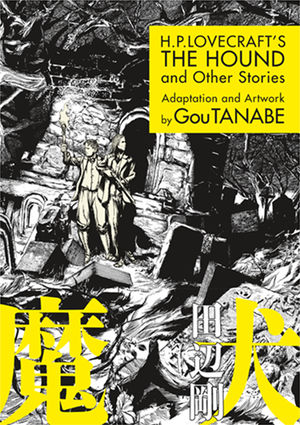If you admire the fecundity of H.P. Lovecraft’s imagination but not the turgidity of his prose, you might find Gou Tanabe’s manga adaptations of The Hound and Other Stories an agreeable alternative to the originals. Tanabe sticks close to the source material while pruning away the florid language characteristic of Lovecraft’s writing, offering more polished — and, frankly, unnerving — versions of three early works: “The Temple,” first published in 1925, “The Hound,” from 1922, and “The Nameless City,” from 1921.
Tanabe is no stranger to literary adaptations; he’s also tackled works by Maxim Gorky (“Twenty-Six Men and a Girl”), Franz Kafka (“A Hunger Artist”), and folklorist Lafcadio Hearn (“The Story of O-Tei”). Lovecraft’s writing, however, occupies a unique place in Tanabe’s oeuvre, as he’s published adaptations of other Lovecraft stories — “The Color Out of Space” (1927) and “The Haunter of the Dark” (1935)” — and expanded Lovecraft’s novella “At the Mountains of Madness” into an ongoing, multi-volume series. Reflecting on his fascination with Lovecraft, Tanabe reverentially describes him as a “priest of his own Mythos,” capable of summoning “unknowable darkness” on the page. “By illustrating his stories,” Tanabe declares, “I intend to become an apostle of the gods he made” (172).
And while Tanabe’s sentiments are a little purple, his affinities with Lovecraft are evident in his artful translation of words into images. Consider “The Temple,” a tense drama set aboard a German U-boat in the waning days of World War II. While Lovecraft’s narrator baldly ascribes the crew’s irrational behavior to “peasant ignorance” and “soft, womanish” dispositions, Tanabe focuses instead on the extraordinary claustrophobia of their environment, cramming every panel with ducts, pipes, valves, levers, and gauges; the walls of the ship seem to press in on the characters as their disabled submarine plunges to its doom. That sense of entombment is heightened by Tanabe’s stark use of tone in the story’s final act, when the light emanating from the ship barely pierces the jet-black depths of the ocean. A fleeting glimpse of a dolphin — normally a symbol of innocent playfulness — becomes a sinister omen when lit from below, its smiling visage transformed into a sneer.
Tanabe also demonstrates a flair for drawing lost cities, evoking the grandeur and mystery of ancient civilizations through sheer scale: his temples and monuments are so large that they spill off the page, while their interiors are cramped and dark, more cave than castle. In “The Nameless City,” for example, we follow the narrator through a labyrinth of dark tunnels, his torch briefly illuminating objects and surfaces that hint at the true nature of the city’s inhabitants. These panels culminate in an extraordinary two-page spread revealing a Romanesque fresco that, on closer inspection, is populated not with demons, angels, and men, but reptilian monsters arranged in concentric circles around a Christ-like figure.
The revelation of who lived there — and how they treated their human subjects — provides a moment of thematic continuity with the other two stories in the anthology. As writer Robert M. Price explains in his forward to The New Lovecraft Circle, Lovecraft’s heroes seek forbidden knowledge, “gradual[ly] piecing together… clues whose eventual destination one does not know.” Price elaborates:
The knowledge, once gained, is too great for the mind of man. It is Promethean, Faustian knowledge. Knowledge that destroys in the moment of enlightenment, a Gnosis of damnation, not of salvation. One would never have contracted with Mephistopheles to gain it. One rather wishes it were not too late to forget it. (xviii–xix)
At the same time, however, the narrator’s terrible discovery exemplifies another important strand in Lovecraft’s writing: a sense of cosmic indifferentism, the idea that the universe is, in Lovecraft’s words, “only a furtive arrangement of elementary particles” that “presage of transition to chaos.” As Lovecraft observed,
The human race will disappear. Other races will appear and disappear in turn. The sky will become icy and void, pierced by the feeble light of half-dead stars. Which will also disappear. Everything will disappear. And what human beings do is just as free of sense as the free motion of elementary particles. (Riemer)
Viewed in this light, the rendering of the fresco seems less like a simple artistic choice by Tanabe than an expression of Lovecraft’s own cosmic indifferentism. By parodying the Christian iconography enshrined on Medieval cathedral walls, ceilings, and portals, Tanabe points both the futility of belief — it didn’t save the monsters, after all — and the inevitability that mankind will repeat the cycle of birth, life, and death that the monstrous fresco depicts.
And if all of this sounds like the ruminations of a freshman philosophy major, fear not; The Hound and Other Stories can still be enjoyed on its own merits. All three stories are well paced and vividly rendered, each embodying the Romantic definition of the sublime — “all that stuns the soul, all that imprints a feeling of terror”— while offering the kind of satisfying twists that pulp fiction readers craved in the 1920s. And for those more invested in the Lovecraft mythos, The Hound provides an opportunity to revisit these stories afresh, seeing them through the eyes of an artist who has dedicated his career to finding the poetry, the mystery, and the weirdness in Lovecraft’s words. Recommended.
References
Price, Robert M. “Introduction.” The New Lovecraft Circle. Del Rey, 2004, xiii-xxvi.
Riemer, Andrew. “A Nihilist’s Hope Against Hope.” Sydney Morning Herald, 28 June 2003, http://www.smh.com.au/articles/2003/06/27/1056683892274.html. Accessed on 11 Oct. 2017.
Tanabe, Gou. H.P. Lovecraft’s The Hound and Other Stories. Translated by Zack Davisson, Dark Horse, 2017.




2 thoughts on “H.P. Lovecraft’s The Hound and Other Stories”
Comments are closed.